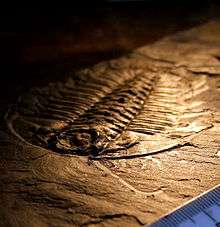Fezouata formation
The Upper and Lower Fezouata formations of Morocco are Burgess shale-type deposits dating to the Lower Ordovician, filling an important preservational window between the common Cambrian lagerstätten and the Late Ordovician Soom shale.[1] In the fossilized fauna were numerous organisms previously thought to have died out after the mid-Cambrian.[2]
Biota
Over 1500 non-mineralized specimens, representing 50 distinct taxa that have a composition similar to earlier Burgess Shale type biotas, have been recovered from the formations in addition to a less abundant shelly fauna.[1] The make-up of the community varies significantly through the stratigraphic sequence, with both abundances and faunal composition changing as time progresses.[1] Small (1–3 mm wide) burrows are present in the sediment, but major burrowing is absent; this may suggest a paucity of oxygen in the water or sediment.[1] Particularly notable is the presence of bryozoa and graptolites,[1] forms that are absent in the Cambrian period. Diverse echinoderms indicate a normal range of salinity, and the overall shelly assemblage is not significantly different from the normal shelly fauna expected in open Ordovician waters.[1] The non-mineralized cohort contains a range of forms familiar from the Burgess Shale: Demosponges,[3] lobopods, barnacles, annelids, anomalocaridids,[4] possible halkieriids, marrellomorphs, paleoscolecid worms, naraoiids, skaniids as well as the expected problematica. Other Ordovician oddballs are also present, including mitrates,[5] machaeridia,[6] cheloniellids and horseshoe crabs in abundance.[1]
Depositional setting
The fossiliferous strata were deposited in quiet, deep waters, below the influence of wave action in all but the fiercest of storms. Such storms, or similar high-energy events, would have mobilized sediment that could be quickly deposited, trapping animals and leading to their preservation.[1] Consequently, the assemblage is dominated by benthic organisms.[1]
Preservation
Fossils of the Fezouata formation, which are usually squashed flat (although some do retain some degree of their original three-dimensionality) are often coated with a dusting of pyrite, and tin??; this aspect of the fossil preservation is very similar to that at Chengjiang.[1] Non-mineralized appendages are often preserved.[1]
Location
The fossils occur within an area of 500 km2, in southeast Morocco's Draa Valley, north of Zagora. Stratigraphically productive layers are found through a 1.1 km-thick column of rock that spans the Tremadocian and Floian epochs.[1]
History
The lagerstätten were first identified in the late 1990s[7] when a local fossil collector, Ben Moula, showed some of the finds to a PhD student who was then working in the area.[8]
References
- 1 2 3 4 5 6 7 8 9 10 11 12 Van Roy, P.; Orr, P. J.; Botting, J. P.; Muir, L. A.; Vinther, J.; Lefebvre, B.; Hariri, K. E.; Briggs, D. E. G. (2010). "Ordovician faunas of Burgess Shale type". Nature. 465 (7295): 215–8. Bibcode:2010Natur.465..215V. doi:10.1038/nature09038. PMID 20463737.
- ↑ (BBC News) Victoria Gill, "Fossil find resolves ancient extinction mystery": accessed 13 May 2010
- ↑ Botting, J. (2007). "'Cambrian' demosponges in the Ordovician of Morocco: Insights into the early evolutionary history of sponges". Geobios. 40 (6): 737–748. doi:10.1016/j.geobios.2007.02.006.
- ↑ Van Roy, P.; Briggs, D. E. G. (2011). "A giant Ordovician anomalocaridid". Nature. 473 (7348): 510–513. Bibcode:2011Natur.473..510V. doi:10.1038/nature09920.
- ↑ Lefebvre, B.; Botting, J. (2007). "First report of the mitrate Peltocystis cornuta Thoral (Echinodermata, Stylophora) in the Lower Ordovician of central Anti-Atlas (Morocco)". Annales de Paléontologie. 93 (3): 183. doi:10.1016/j.annpal.2007.06.003.
- ↑ Vinther, J.; Van Roy, P.; Briggs, D. (2008). "Machaeridians are Palaeozoic armoured annelids". Nature. 451 (7175): 185–188. Bibcode:2008Natur.451..185V. doi:10.1038/nature06474. PMID 18185586.
- ↑ Van Roy, P; Lefebvre, B; El Hariri, K; Hafid, A (2008). Exceptionally Preserved Faunas from the Lower Ordovician of the Anti-Atlas, Morocco (PDF). First international Conference and Exhibition, Marrakech, Morroco.
- ↑ Jones, N. (2010). "Weird wonders lived past the Cambrian". Nature. doi:10.1038/news.2010.234.
